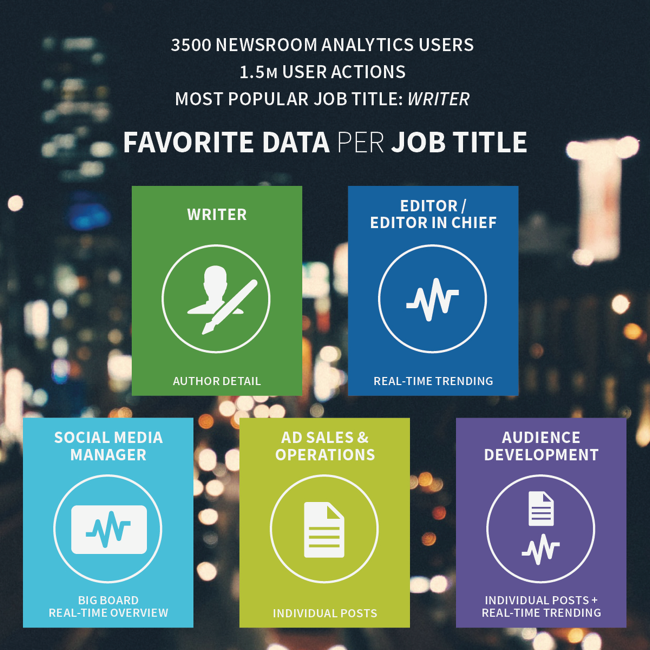Three Myths About Using Analytics in the Newsroom
“So exactly how hard is it to find a needle in a haystack, anyway? And can water dripping on your forehead really drive you nuts? Those are the kinds of questions, myths and urban legends that are put to the test in this humorous series that seeks to find out which myths are true and which are not.” – MythBusters
The MythBusters evaluate urban legends, but they don’t delve into the realm we care about — the myths that persist about analytics for media companies.
When I speak with someone at a media company that is not using Parse.ly, I hear some variation of the same few concerns over and over again. Although widely held, these concerns are often unfounded: they’re myths.
So today, I’m here to bust them.
“We’re what you call experts; we do this for a living.”
Admittedly, this won’t be quite as fun as watching car crashes or finding out that you can break out of jail with dental floss, but I do think the Mythbusters would applaud our efforts to demystify the world of data and analytics.
Myth 1: Data and analytics are complex and best left to the analysts.
Data and analytics can be complex, and there are things that analysts or data scientists can do that others can’t. Does that mean that highly trained specialists are the only ones that should ever get near data?
MYTH BUSTED: Data can (and should) be accessible to everyone.

If it were true that data is best left to analysts, you would expect that most of the users of a publishing analytics platform, like Parse.ly, would be analysts. In a recent review of who our users are and what they do, we found editors, reporters, and social media/audience development roles make up the largest percentage of our users.
Why? These people know their stories and content best. They can spot trends in ways that analysts can’t, and they can do it faster which makes a big difference in the digital world. Also, giving everyone access to data that they can understand and use actually means that the analysts and data teams have more time to dive into the more interesting questions — everyone wins.
Myth 2: Exposure to data lowers company morale.
Some publishing executives have a fear that exposing writers or editors to data will cause morale to plummet. There are certainly some examples of bad rollouts and poorly conceived executions of analytics within companies.
MYTH BUSTED: Data can boost morale in unexpected ways.
If you are open to expanding the definition of “performing well” beyond page views and scale, data can uncover hidden success stories.
Chris Brudele, director, research and analytics at The Daily Beast, has explained that — though data is absolute — interpretation is relative. Writers have come to him disappointed that a passion project story didn’t hit expected page views or perform as well as they hoped. He is able to point to data to show these writers the aspects of the audience’s reaction that they might have missed: engaged time may have been higher than most other articles, or maybe the article brought in more consistent and loyal traffic over time. Brudele believes that helping his team understand the bigger picture with data has made The Daily Beast more successful overall.
The Telegraph reported a similar finding. Their team told us that they were “keener to acknowledge” that there are different types of reporters that can be considered successful thanks to seeing the data.

A quick word of warning: Introducing any new platform without some thought and planning can backfire and lower morale. But when organizations agree on how analytics will be used in concert with company or departmental goals, data can shine light on underappreciated work.
Myth: Data will force me to reduce my site’s values and goals to one number.
Sometimes the conversation around data and analytics makes it possible to forget that media sites exist to serve a public service: creating a more informed audience. Will data and analytics change that end goal?
MYTH BUSTED: I’ll let someone else bust this one…
Jonathan Stray, a fellow at Columbia University’s Tow Center for Digital Journalism, summed up my feelings on the matter in a discussion prompted by a Media Impact Project online forum.
Journalism is very much a multi-stakeholder endeavor, so why should we imagine that a single number can capture all aspects of the activity?
Putting metrics into context can show multiple paths to success, whether that be success in public impact or creating revenue.
Other projects have found this to be true in the non-profit journalism space. Brian Abelson and Michael Keller approached this topic when trying to study impact metrics for journalism. From their report:
As nonprofit newsrooms apply for grants and appeal to donors for funding, they often need to explain in formal reports ‘how well’ their stories performed—not just in terms of impressive traffic but in qualitative evaluations of the impact their reporting had on the world: Did it change a law? Did it move the needle in the conversation? Did it meet the expectations—however defined—the organization had for it?
And later, they write:
While quantitative metrics are often vilified as leading journalism astray from its true purpose, the researchers found they do help tell the story of a newsroom’s performance. Although this project began with an interest in giving more visibility to qualitative measurements, its founders repeatedly heard reports from newsrooms that quantitative measurements play an important role for organizations wanting to tell a long-term story of audience growth.
For companies focused more on revenue, connecting the dots between analytics and editorial can create products and services that help them to become less reliant on only one form of revenue (i.e. advertising at scale). For example, Ars Technica, a Condé Nast property, has used its editorial analytics to create a premium ad product called “The Accelerator” that guarantees that a brand’s ads will show on viral and trending stories.

So now that I’ve busted the biggest myths, what other “urban legends” still remain about data and analytics? Tweet me your questions @sachinkamdar and I’ll take them on, too.
I will leave C4 myths to the original MythBusters though.
